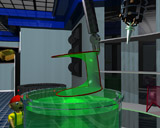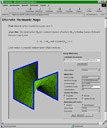Geometry on the Internet
For a number of years the internet has been a technical infrastructure
connecting computers to a global network, but in recent years it has emerged as the
world-wide-web, a global information network similar to a gigantic hypertext book.
Hypertext books have been around for quite some years, for example, digital help systems
of software applications have been among the first to use software links between different
sets of informations. Mainly the success of hypertext books made written manuals obsolete
so that nowadays software is solely accompanied by digital manuals. Classical hypertext
books have a similar linked structure as the web but the information is usually stored
locally. The new dimension of the web allows to imagine the human's knowledge as a
worldwide digital encyclopedia which is directly accessible by all people rather than by
those living in the vicinity of the local library.
 The
success of the world-wide web was not planned. It is one of the achievements that happen
in the modern computer world where suddenly a far-reaching answer to the problems of a
large number of people appears. Among the major reasons of the success of the
world-wide-web are the global standards which have been established for the document
format HTML, the network protocol HTTP, and the software browsers. While the network
protocol is based on the internet protocol TCP/IP which has been used in the academic
domains for a number of years, it was the simple new document format HTML which helped to
attract so many people. This format is easy to read and to write on nearly all computer
systems, and it allows to include multimedia elements like images, sound, video, and other
data. From the beginning of world-wide-web, browsers had a simple user interface which
allowed immediate access to all kinds of information and thereby succeeded to replace
complicated software tools previously used in the academic internet.
The
success of the world-wide web was not planned. It is one of the achievements that happen
in the modern computer world where suddenly a far-reaching answer to the problems of a
large number of people appears. Among the major reasons of the success of the
world-wide-web are the global standards which have been established for the document
format HTML, the network protocol HTTP, and the software browsers. While the network
protocol is based on the internet protocol TCP/IP which has been used in the academic
domains for a number of years, it was the simple new document format HTML which helped to
attract so many people. This format is easy to read and to write on nearly all computer
systems, and it allows to include multimedia elements like images, sound, video, and other
data. From the beginning of world-wide-web, browsers had a simple user interface which
allowed immediate access to all kinds of information and thereby succeeded to replace
complicated software tools previously used in the academic internet.
 The origin of the
world-wide-web is a good example of another aspect of the web beside the publication and
presentation of information, namely, communication. In fact, the HTTP protocol, which is
the underlying technical protocol for internet connections, was defined at CERN in
Switzerland to support communication and exchange among large groups of scientists
involved in physical experiments. Often these groups involve more than hundreds of
scientists located at different places in the world who must exchange experimental data
and communicate research results in efficient ways. This means that the origin of the web
is not related with presentation, which made the web popular, but with communication among
people. The communicative aspect of the web is becoming again its original importance and
is the main attraction of the web nowadays.
The origin of the
world-wide-web is a good example of another aspect of the web beside the publication and
presentation of information, namely, communication. In fact, the HTTP protocol, which is
the underlying technical protocol for internet connections, was defined at CERN in
Switzerland to support communication and exchange among large groups of scientists
involved in physical experiments. Often these groups involve more than hundreds of
scientists located at different places in the world who must exchange experimental data
and communicate research results in efficient ways. This means that the origin of the web
is not related with presentation, which made the web popular, but with communication among
people. The communicative aspect of the web is becoming again its original importance and
is the main attraction of the web nowadays.
When considering the web as a global digital library, is there still a
place for maintained libraries and encyclopedias? In fact, such managed collections are
still important since they ensure a certain quality, a managed database, and well-defined
access. The global web contains a huge amount of information but it is often hard, and
becomes even harder, to find the good information among the non-relevant. Information must
be preselected to be really useful, and current search engines are just starting with
methods for ranking and sorting information by quality.
Geometry is the content in this setting which we are now going to
exhibit in greater detail. The special characteristic of geometry is its rich fundus of
shapes, images, and dynamic applications which make it an ideal candidate for profiting
from the internet.
One of the most attractive new components of the web is the ability to
present and communicate complex interactive experiments. Performing experiments has always
been the domain of experts, more concrete, of those experts who wrote the simulation
software. One reason is the user interface design which has been difficult to create for
unix computers since user interface builders are not so common in this area. Another
reason is the lack of incentive for a programmer to create a well-thought user interface
since scientific programs usually require specialized hardware and will seldom reach a
wide-spread audience. Since the arrival of the new programming language Java in 1995 the
situation changed dramatically. For the first time it is possible to create software which
runs on any computer platform and operating system without the delicate process of
rewriting and adjusting source code for each new system.
Java is usually installed automatically on a computer at the same time
when a browser is installed. In contrast to other high-level programming languages like
Fortran, C or C++, the language Java comes also with a full-featured set of graphical user
interface structures. These structures are not supplied by other parties but incorporated
into the definition of the language itself. The design of a user interface is one of the
major tasks when implementing a reusable experiment, and in previous times it was the one
of the reasons why software was restricted to special computer platforms. Platform
dependent interface code restricts software to distinguished platforms. Since Java
includes the graphics user interface directly in its language specifications, Java
programs run per default on any computer with installed Java.
 The
success of the world-wide web was not planned. It is one of the achievements that happen
in the modern computer world where suddenly a far-reaching answer to the problems of a
large number of people appears. Among the major reasons of the success of the
world-wide-web are the global standards which have been established for the document
format HTML, the network protocol HTTP, and the software browsers. While the network
protocol is based on the internet protocol TCP/IP which has been used in the academic
domains for a number of years, it was the simple new document format HTML which helped to
attract so many people. This format is easy to read and to write on nearly all computer
systems, and it allows to include multimedia elements like images, sound, video, and other
data. From the beginning of world-wide-web, browsers had a simple user interface which
allowed immediate access to all kinds of information and thereby succeeded to replace
complicated software tools previously used in the academic internet.
The
success of the world-wide web was not planned. It is one of the achievements that happen
in the modern computer world where suddenly a far-reaching answer to the problems of a
large number of people appears. Among the major reasons of the success of the
world-wide-web are the global standards which have been established for the document
format HTML, the network protocol HTTP, and the software browsers. While the network
protocol is based on the internet protocol TCP/IP which has been used in the academic
domains for a number of years, it was the simple new document format HTML which helped to
attract so many people. This format is easy to read and to write on nearly all computer
systems, and it allows to include multimedia elements like images, sound, video, and other
data. From the beginning of world-wide-web, browsers had a simple user interface which
allowed immediate access to all kinds of information and thereby succeeded to replace
complicated software tools previously used in the academic internet. 